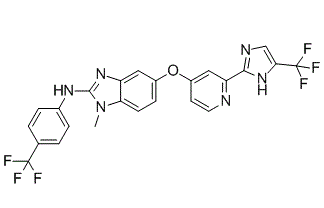| Cas No.: | 927880-90-8 |
| Chemical Name: | 1-methyl-5-(2-(4-(trifluoromethyl)-1H-imidazol-2-yl)pyridin-4-yloxy)-N-(4-(trifluoromethyl)phenyl)-1H-benzo[d]imidazol-2-amine |
| Synonyms: | CHIR265,RAF-265,CHIR 265, |
| SMILES: | FC(F)(C1=CN=C(N1)C2=NC=CC(OC3=CC=C4N(C(NC5=CC=C(C(F)(F)F)C=C5)=NC4=C3)C)=C2)F |
| Formula: | C24H16F6N6O |
| M.Wt: | 518.41 |
| Sotrage: | 2 years -20°C Powder, 2 weeks 4°C in DMSO, 6 months -80°C in DMSO |
| Description: | RAF265 is a potent RAF/VEGFR2 inhibitor. |
| In Vivo: | In single-compound efficacy studies, optimal dosing of RAD001 and RAF265 is 5 to 12 mg/kg daily and 30 mg/kg every two days, respectively. However, combination tolerability studies in nontumor-bearing mice defin dose-limiting toxicity as a 10% weight loss with the combination of RAD001 at a dose of 12 mg/kg daily and RAF265 at a dose of 20 mg/kg every two days. Therefore, the combination of RAF265 at a dose of 12 mg/kg qd and RAD001 at a dose of 12 mg/kg qd seems to be the maximal tolerated dose. RAD001 and RAF265 are both given at a dose of 12 mg/kg qd, alone or concurrently, over 6 days. After a 2-day stop, the compounds are given for another 6 days, and the treatment is then stopped. To confirm the potential of the combination of RAF265 and RAD001, the antitumor effect of the combination is tested in HCT116 xenografts (KRAS mut, PIK3CA mut). In HCT116 xenografts, RAD001 or RAF265 given alone shows 60% to 65% and 71% to 72% TVI%, respectively[1]. |
| In Vitro: | The MTT assay reveals that in HT29 and MDAMB231 cells, RAF265 alone shows significant activity with IC20 values of 1 to 3 μM and IC50 values of 5 to 10 μM. In A549 and HCT116 cells, IC20 values are 1 μM for both, but RAF265 concentrations up to 10 μM do not reach IC50 values. However, in the presence of 1 nM RAD001, the IC50 for RAF265 is 5 μM in A549 cells and 10 μM in HCT116 cells[1]. |

 DC Chemicals' products qualify for U.S. tariff exemptions. We guarantee no price increases due to customs duties and maintain stable supply, continuing to deliver reliable research solutions to our American clients.
DC Chemicals' products qualify for U.S. tariff exemptions. We guarantee no price increases due to customs duties and maintain stable supply, continuing to deliver reliable research solutions to our American clients.





















